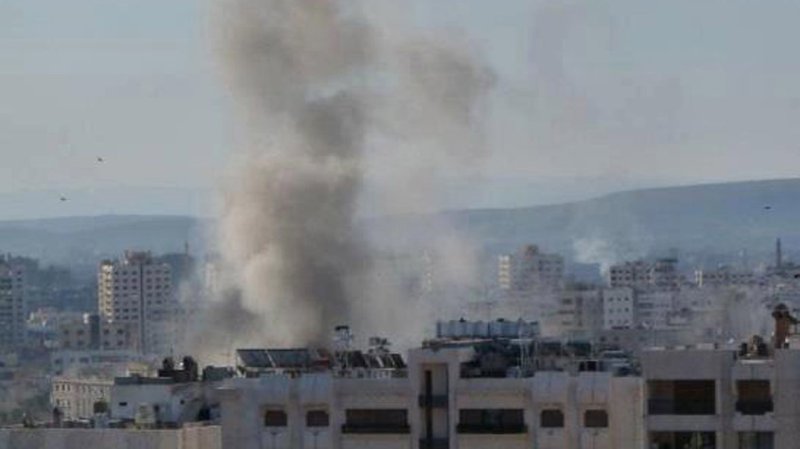Smoke rises from Damascus after two explosions hit security complexes in the Syrian capital Damascus on March 17, 2012. Syrian health ministry officials said that at least 27 people were killed and 97 injured in the twin explosions that hit the Syrian capital Damascus. One explosion occurred near the Syrian Air Force intelligence headquarters, Syrian television said. UPI |
License Photo
BEIRUT, Lebanon, March 13 (UPI) -- Syrian warplanes have been bombing the northern cities of Homs and Raqqa, and even the outskirts of Damascus, to block advancing rebel forces, attacks that underline the critical role the air force in the Damascus regime's battle to stay in power.
"The Syrian air force is the main advantage the regime has over the rebels," the U.S. global security consultancy Stratfor observed.
"It has afforded the regime substantial firepower and logistic capabilities, providing for the support of far-flung isolated outposts. Without the air force, the battle would tip more swiftly in favor of the rebels."
But, the air force is being steadily degraded through combat losses and a dwindling supply of spares and Damascus has had to turn to its allies -- Russia and Iran -- to help keep its Soviet- and Russian-built aircraft operational.
"Even so, Damascus will not be able to halt the slow degradation of its air force," Stratfor noted.
"Despite Iranian and Russian support, the air force's current rate of attrition combined with rebel seizures of airfields suggest the air force will continue to see its capabilities degraded as the conflict progresses."
On top of that, reports from the combat zones across Syria indicate that rebel air-defense capabilities have improved.
This is particularly so in the north, near the Turkish border, where rebel forces have made substantial gains in recent months as they acquired more advanced weapons, funded by Saudi Arabia and Qatar or seized from Syrian forces.
The rebels' acquisition of surface-to-air missiles and 14.5mm and 23mm anti-aircraft guns has "forced the Syrian air force to fly at higher altitudes," Stratfor reported.
Even so, it added, in recent months "the air force has greatly accelerated its tempo of operations to match the rising intensity of rebel operations ... and has continued to mount heavy airstrikes."
Before the civil war began March 15, 2011, the Syrian air force had 365 combat capable aircraft, the Military Balance issued by the International Institute for Strategic Studies in London stated.
These included 240 ground-attack jets, which are better suited to counterinsurgency operations than air-superiority fighter aircraft designed for dog-fighting. Among the ground-attack variants were 105 MiG-21MFs, NATO designation Fishbed; 50 Sukhoi Su-22 Fitter fighter-bombers and 20 Su-24 Fencers.
The air force also had 35 Russian-built Mi-25 Hind D helicopter gunships, formidable aircraft that the Soviets used to savage Islamist mujahidin guerrillas in the 1979-89 Afghanistan war until the United States gave the Islamists Stinger anti-aircraft missiles.
It's not clear what Syrian air force losses have been over the last two years but around two dozen fixed-wing aircraft and gunships are known to have destroyed in the air or on the ground by the rebels.
In February, Western diplomats accused Russia of reneging on a pledge made a month earlier to stop supplying arms to the regime. The Russians claim there was no U.N. prohibition of such shipments and said they were simply meeting contractual obligations.
These included air-defense systems. There were reports the Kremlin was possibly preparing to ship Yakovlev Yak-130 jets, training aircraft that can be armed with missiles for ground-attack missions.
Russia's state arms exporter, Rosoboronexport, has a $550 million contract to supply 36 of these aircraft to Syria. However, none is known to have been delivered.
In June 2012, a Russian-operated freighter, the Alaed, carrying Mi-24 helicopter gunships and air-defense missiles for Syria was forced to turn back after British insurers withdrew coverage for the shipment.
Syrian air power was first deployed last summer. The heaviest surge of airstrikes took place in October, particularly in the north, where rebel forces had made significance advances.
More than 60 raids were carried out across the country on Oct. 30.
Most weren't against military targets but random attacks on civilian areas, often using crude home-made bombs such as the so-called "barrel bombs -- canisters stuffed with dynamite, oil and pieces of steel -- aimed at killing civilians to force them to turn on the rebels.





